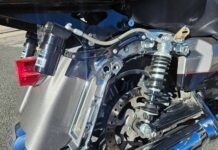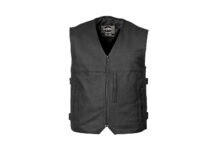Rush Racing Products
#8131 Black 2:1 Full System ’91–’05 with 2.25″ baffles
3522B-R1R
$649.95
rushracingproducts.com
In the early part of 2014, my 2000 FXD underwent a top- and bottom-end engine rebuild, which promised many thousands of miles’ riding pleasure. Sure enough, the high-performance S&S components that had been added have thus far proven to be bullet proof. But it wasn’t until the summertime that I discovered just how hot that motor really was.
The Dyna had started its life with Harley’s 88″ Twin Cam motor, and some years later I’d upgraded it to Harley’s 95″ Big Twin. I noticed the additional heat that was generated, and although I expected the now-106″ motor to put out even more heat, my legs were now suffering more from the higher temperature. And I proceeded to melt and ruin yet another pair of rain pants. My first attempt to mitigate the discomfort was to install Küryakyn’s Saddle Seat Heat Deflectors, which saved my thighs from burning up. However, after an hour-long ride in the hot weather during Laconia Motorcycle Week, I couldn’t put my right leg down without roasting it. Even with exhaust wrap, the blast of heat was unbearable.

exhaust port. Heat from the front pipe was reduced from 493 to 187 degrees after the install.
I sought a solution and was fortunate to find it at Weirs Beach. There, at the Lobster Pound, Cycle Solutions had set up their mobile rig, which included a dyno trailer, several lifts and a retail showroom. Cycle Solutions tunes several thousand motorcycles per year at more than 25 major motorcycle rallies across the country. During the off-season, they do installs and tuning and such at their shop in Hartford City, Indiana (cyclesolutionsonline.com). I knew of their excellent reputation, but what attracted me that day was their huge display that proclaimed, “Heat Elimination Packages for Bikes and Trikes.” Listed on the display board were products such as the ThunderMax EFI module, K&P Auxiliary Oil Cooler/Filter, Cycle Solutions JetScream Billet Breather System, Rush Racing Ceramic Coated Headers, Lucas 50wt Synthetic Oil and Feuling Oil Filter/Cooler.

exhaust port. Heat from the rear pipe
was reduced from 579 to 206.
Cycle Solutions owner Chris Waddell was busy with dyno tuning a customer’s bike so during a break in the action, I explained my problem to him. He agreed that a Rush exhaust would be a great solution (I already had most of the other recommended components or their equivalents installed) and he suggested that I get a Rush 2:1 Full System installed during the Sturgis Motorcycle Rally where his mobile rig would be set up.
After I got home, I contacted Rush Racing Products, and the techs agreed that the Rush 2:1 Full System would work well for my Dyna. The entire system has double ceramic coating inside and out and includes full heat shields available in either chrome or black powder coat. The pipes are made of heavy-duty, 16-gauge steel, which is much thicker than the 18-gauge steel used by most other manufacturers. The chrome exhaust kit includes a chromed aircraft billet end cap and the black system includes a black end cap, although different tips can be purchased separately. And all mounting hardware is included, although Cycle Solutions recommends their $42.95 Exhaust Flange and Gasket Kit to ensure there will be no exhaust leaks after the install.
Rush offers a choice of three spiral, louver-packed baffles: 2.00″, 2.25″ or 2.50″. The recommendation for my 106″ was the 2.25″ baffle; just the right size to provide enough back pressure for an increase in torque. It was explained that although the 2″ baffle is the quietest (I’m not a fan of outrageously loud pipes), it is more suited for stock or mildly-modified motors. The 2.50″ baffle was deemed too large as it is intended for motors much bigger than a 106″. And the bigger the baffle, the louder the noise, with about a 4 dB difference between each baffle size. So I chose the black powder-coated finish to complement the blacked-out style of my bike, the 2.25″ baffle and I kept the included end cap because I thought it looked quite stylish.
The Rush staff promised they’d ship the exhaust to Cycle Solutions in advance of the rally so that I could schedule the install to be done there. When I arrived at the Cycle Solutions location at the western end of Lazelle Street, Chris did a baseline dyno run so that we could do a horsepower and torque comparison once the install was complete. Then, while the motor was still hot, he used a Raytek infrared thermometer to measure the front and rear head pipes near the exhaust ports for later comparisons.
As we waited for the bike to cool down, Chris told me about his experiences with the Rush exhaust. He explained, “What got me on this ceramic kick is that over three years ago Rush sent me a set of their head pipes and I put them on a 2012 103″ Road Glide. We put on new mufflers, installed a ThunderMax EFI system and the customer provided a Screamin’ Eagle breather. Rush had been claiming all kinds of heat reduction. I knew of some ceramic stuff for the automotive industry but no one had come out with anything for bikes. I was blown away by how much less heat there was after wringing that motorcycle’s neck on the dyno. I took a Raytec thermometer and measured it right at the head at the exhaust port, right by the exhaust stud, and it was 400-some degrees. And then three inches from there on the ceramic it was like 80 or 90 degrees where it is typically the same temperature as at the head, or even hotter because the head of the motorcycle tends to contain some of the heat internally and when the exhaust itself comes out, it’s wicked hot. I was blown away by it so we started selling some of these packages.”

Then Keith “Katfish” Jones, product/tech specialist for Rush, expounded on the exhaust system’s attributes. “The pipes will run 300 to 400 degrees cooler and, if tuned properly, will never blue because ceramic can withstand higher heats. They get really good performance because there’s no drag inside the pipe due to the ceramic coating. And it doesn’t let the heat dissipate inside the head pipe; it flows evenly out the muffler. The baffles are interchangeable and also repackable, and major power gains can be achieved with the right combination.”
Cycle Solutions tech Shaun Hardesty completed the install in short order, and the FXD went back in the trailer for another dyno run. I figured that the last tuning session months before had squeezed every bit of horsepower and torque out of my current engine configuration, but happily, I was wrong. There was a slight increase in horsepower (not surprising because the bike had never had any head work done), but the dyno numbers showed an astounding 11-percent increase in torque—a really nice bonus when all I was looking for was relief from the intense heat emanating from the head pipes.

complementing the blacked-out theme of my Dyna
And relief was what I found. Before I left the Cycle Solutions rig, Chris remeasured the exhaust header-pipe heat with the Raytek gun. Before the Rush exhaust install, the front pipe measured 493 and the rear 579. After attaining approximately the same engine temperature after the install, the front showed 187 and the rear 206. That’s quite a difference, but to me, the real test took place on my 1,800-mile ride home from Sturgis. It was heaven. The way Katfish had described a customer’s bike during Chris’s customer bike demonstrations in Sturgis, “It doesn’t feel like anything more than a warm breeze,” was the only thing I experienced whenever I put my right leg down. That said, don’t get lulled into wrapping your hands around the pipes. A lot of heat is still passing through the exhaust!
Care of the exhaust system is cheap and easy—soap and water is the only cleaner that’s needed. Lucas Slick Mist Speed Wax can also be used for the finish. Just don’t use anything abrasive. Exhaust systems come with a one-year manufacturer’s warranty, and if any component needs to be replaced, such as a heat shield, muffler, or head pipe, pretty much every component is available separately. All in all, the Rush 2:1 Full System has exceeded my expectations in every way, and I haven’t ruined any pants legs since the install.




















This is a horrible company with the worst customer service in the industry. Buyer beware. Still haven’t received my parts after 3 months.